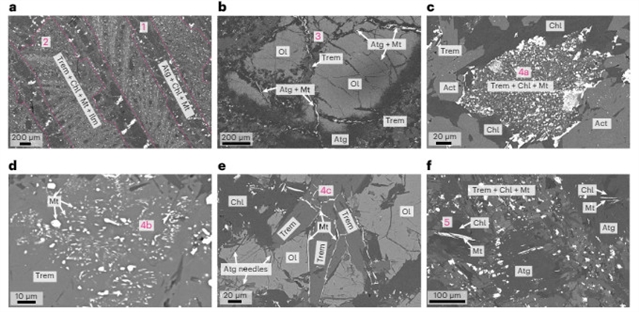
瑞士伯尔尼大学 Tamblyn, R. 和 Hermann, J. 经过不懈努力取得了太古宙科马提岩高氢气产量的地质证据。2023年11月6日出版的《自然—地球科学》杂志发表了这项成果。
本文探究了太古宙克拉通中玄武岩—科马提岩岩石记录中 H2 产生的证据。对科马提质玄武岩—科马提岩的 38 种样本的岩石学研究中,研究人员辨认出是独特的蛇纹石化反应引起这些岩石产生 H2。研究使用超过 1,100 块岩石,在对这些岩石进行地球化学分析的支持下,研究人员直接量化了太古宙科马提岩的 Fe3+ 和 H2 产量。科马提岩流体的化学(高 Mg)和物理(低粘度流动)特征,允许其在海洋板块中,进行广泛的水化和蛇纹石化作用,可以为化学合成早期生命提供高 H2 产量。
据介绍,在水下蚀变过程中,岩石中铁的氧化是分子氢(H2)的关键来源,过去被用作化学合成生物的能量来源,这可能代表了地球上最早的生命形式。太古宙时期,可用于蛇纹石化反应释放 H2 的超镁铁质物质的潜在来源是科马提岩。科马提岩是一种高镁质熔岩,含有接近太古宙海底、大量的蛇纹石化和磁铁矿(Fe2+Fe3+2O4)的证据。过去,许多学者已经对科马提岩成分中的 H2 产量进行了建模和实验研究,然而,天然岩石中的记录仍未被探索。
附:英文原文
Title: Geological evidence for high H2 production from komatiites in the Archaean
Author: Tamblyn, R., Hermann, J.
Issue&Volume: 2023-11-06
Abstract: The oxidation of iron from rocks during subaqueous alteration is a key source of the molecular hydrogen (H2) used as an energy source by chemosynthetic organisms, which may represent some of the earliest forms of life on Earth. In the Archaean, a potential source of ultramafic material available for serpentinization reactions that release H2 are komatiites. Komatiites are highly magnesian lavas, which contain evidence of extensive serpentinization and magnetite (Fe2+Fe3+2O4) production close to the Archaean seafloor. H2 production in komatiitic compositions has been modelled and experimentally investigated; however, the natural rock record has remained unexplored. Here we examine the geological evidence of H2 production from the basaltic to komatiitic rock record held in Archaean cratons. From the petrological investigation of 38 samples of komatiitic basalt to komatiite, we identify the unique serpentinization reaction responsible for H2 production from these lithologies. With support from over 1,100 bulk rock geochemical analyses, we directly quantify Fe3+ and therefore H2 production of komatiites in the Archaean. The chemical (high Mg) and physical (low viscosity flow) characteristics of komatiite flows allowed for extensive hydration and serpentinization in oceanic plateaus and therefore high H2 production available to chemosynthetic early life. Serpentinization of komatiites produced large quantities of H2 in the Archaean, which has implications for the start of early chemosynthetic life, according to petrologic and bulk rock chemical analyses.
DOI: 10.1038/s41561-023-01316-x
Source: https://www.nature.com/articles/s41561-023-01316-x
